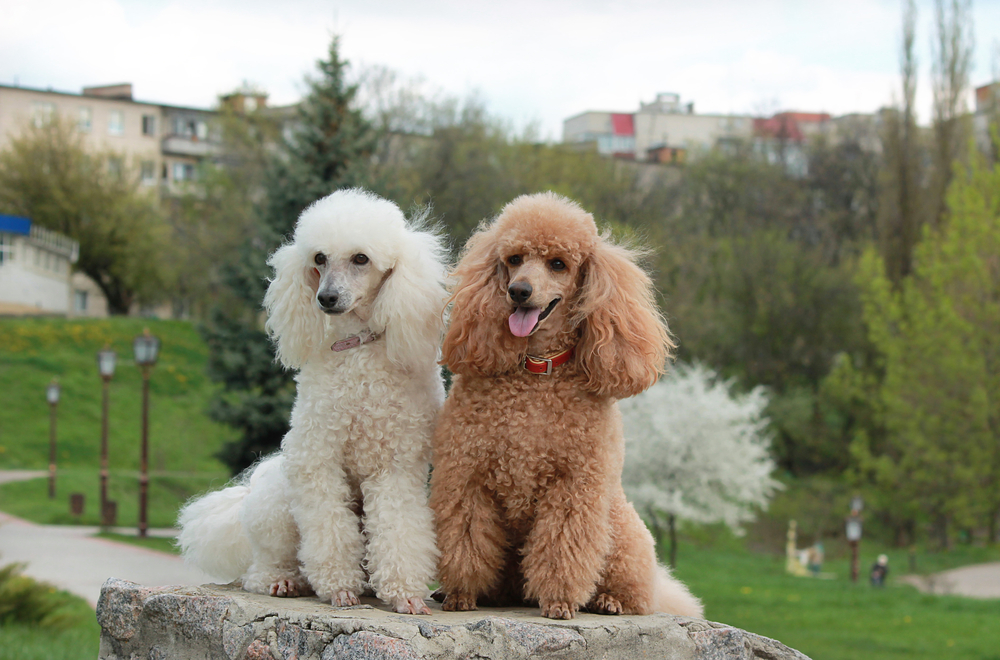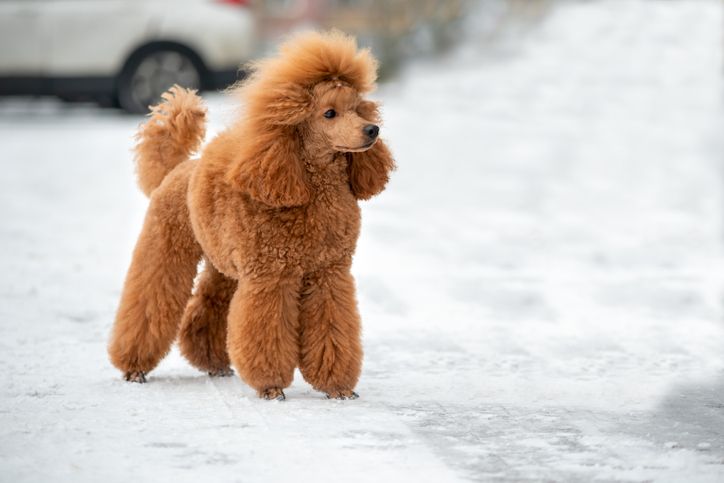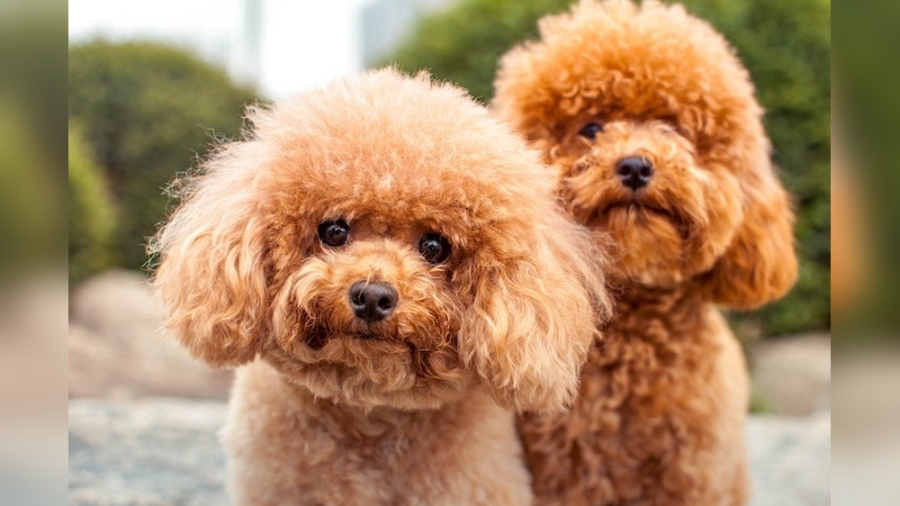Are you worried about allergies but still want to welcome a furry friend into your home? You might have heard that Poodles are a great option for allergy sufferers.
But do Poodles have pet dander—the tiny skin flakes that often trigger allergic reactions? Understanding how much dander a Poodle produces can help you decide if this breed fits your lifestyle and keeps your allergies in check. You’ll discover why Poodles are often called hypoallergenic, what makes their coat special, and important tips to manage pet dander effectively.
Keep reading to find out if a Poodle could be the perfect companion for you and your family.
Poodle Coat And Dander
Poodles have a unique coat that plays a key role in dander production. Their hair grows continuously and forms tight curls. This texture helps trap dander and prevents it from spreading easily. Unlike many breeds, poodles shed very little hair and skin flakes.
Because of this, poodles produce less loose dander in the environment. Less dander means fewer allergy triggers for sensitive individuals. Their coat acts like a natural barrier, holding most dander close to the skin.
Poodle Hair Vs. Fur
Poodles have hair, not fur. Hair grows longer and falls out less often. Fur sheds regularly, releasing more dander into the air. The difference helps explain why poodles are often better for allergy sufferers. Hair keeps dander trapped inside the curls instead of spreading around the home.
How Curly Coats Trap Dander
The tight curls of poodles create a dense barrier. This layer captures dead skin cells before they can float away. It also reduces the amount of loose hair that carries dander. The coat’s structure limits airborne allergens, making the air cleaner around poodles.
Shedding And Dander Release
Poodles shed very little compared to many dogs. Low shedding means fewer hairs and skin flakes fall off. This results in less dander in homes and on furniture. Regular grooming helps remove trapped dander from their curls, keeping the coat healthy and clean.

Curly Hair Benefits
Poodles have curly hair that traps pet dander, reducing its spread in the air. They shed very little, making them a good choice for allergy sufferers. Still, no dog is completely free of dander.
Poodles have a unique curly coat that offers special advantages. Their hair curls tightly, creating a dense barrier. This barrier helps to trap pet dander, which are tiny skin flakes that can cause allergies.
The curls prevent dander from easily falling off and spreading in the air. This means less dander floats around your home. People with allergies often find Poodles easier to live with than other breeds.
Reduced Shedding
The curly hair of Poodles sheds very little. Less shedding means fewer loose hairs and less dander released into your environment. This helps keep your living space cleaner and reduces allergic reactions.
Since hair and dander stay mostly trapped in the curls, regular grooming is important. Brushing helps remove loose hair and dander before it falls off.
Better Allergy Control
The curly coat acts like a filter, holding onto dander close to the dog’s skin. This reduces how much dander enters the air and your home. It can help allergy sufferers feel more comfortable around dogs.
While no dog is completely hypoallergenic, Poodles offer a natural way to control dander spread. Their curly hair makes them one of the better choices for people with mild dog allergies.
Shedding Patterns
Poodles are famous for their unique coats. Their shedding patterns differ from many other breeds. Understanding these patterns helps allergy sufferers choose the right pet.
Unlike dogs that shed large amounts of hair, Poodles shed very little. Their hair grows continuously, similar to human hair. This means less loose hair and fewer allergens floating around.
Minimal Shedding
Poodles shed hair slowly and in small amounts. Their curly hair traps loose strands, stopping them from falling off easily. This reduces the spread of dander in the home.
Seasonal Shedding
Poodles do not have strong seasonal shedding like some breeds. They may lose a bit more hair in spring or fall, but it is usually very mild. Regular grooming helps manage even this small shedding.
Coat Maintenance And Shedding Control
Regular brushing removes loose hairs and dander from the coat. Grooming every 4 to 6 weeks keeps the coat healthy and clean. Well-maintained coats mean less hair and dander in your living space.
Hypoallergenic Status Explained
Poodles produce less pet dander due to their curly, low-shedding coat. This helps trap dander, reducing airborne allergens. While not fully hypoallergenic, they are often better for allergy sufferers than many other breeds.
Poodles are often called hypoallergenic dogs. This term means they cause fewer allergy problems. Allergies come from pet dander, tiny skin flakes that pets shed.
Poodles have hair, not fur. Their hair grows continuously and sheds very little. This helps trap dander close to the skin.
Because of their curly coat, dander stays in the hair instead of flying into the air. This lowers allergy triggers for many people.
Why Poodles Produce Less Dander
- Curly Coat: Poodles’ curly hair holds dander tightly. It stops dander from spreading around the house.
- Low Shedding: They shed very little hair and skin flakes. Less shedding means less dander in the environment.
Important Considerations
- Not Truly Hypoallergenic: No dog is 100% hypoallergenic. Dander comes from skin cells, which all dogs have.
- Allergy Varies by Dog: Each dog produces different amounts of dander. Some Poodles may cause more allergies than others.
- Coat Care is Essential: Regular grooming keeps the coat clean. Brushing prevents matting and helps trap dander.
Individual Allergy Differences
Allergy reactions differ from person to person, even with poodles. Poodles produce less dander because their curly hair traps it. Still, some individuals may react differently to each dog’s dander level.
Understanding Individual Allergy Differences
Allergies to dogs vary greatly from person to person. Some people react strongly to certain breeds, while others do not. This difference depends on how the immune system responds to pet dander.
Poodles produce less dander than many other dogs. Their curly hair traps dander close to the skin. This reduces the amount of allergens released into the air.
Even with low dander, some individuals may still have allergic reactions. Sensitivity levels can differ widely among allergy sufferers.
Why Some People Are More Sensitive
People’s immune systems react differently to pet proteins. Some may have mild symptoms, such as sneezing or itchy eyes. Others may experience more severe reactions like asthma or skin rashes.
Allergy severity depends on individual biology and exposure level. A small amount of dander might trigger symptoms in one person but not in another.
Testing For Dog Allergies
Allergy testing helps identify specific triggers. Doctors may use skin or blood tests to check reactions to dog dander. This helps people understand if poodles or other breeds cause allergies.
Knowing your sensitivity allows for better pet choices and allergy management. It also guides precautions to reduce exposure at home.
Managing Allergies With Poodles
Regular grooming reduces dander buildup on poodles. Frequent brushing and bathing help keep allergens low. Using air purifiers also improves indoor air quality.
People with mild allergies may tolerate poodles well. Others might need medication or allergy shots to control symptoms.

Grooming And Dander Control
Grooming plays a vital role in controlling pet dander on Poodles. Their curly coats trap dander effectively, but regular care is necessary to keep it under control. Without proper grooming, dander and loose hair can build up and cause allergy problems.
Maintaining a clean coat helps reduce airborne allergens and keeps your home fresher. Poodles need consistent brushing to prevent mats and tangles where dander can hide. Bathing also removes dead skin cells and excess oils that contribute to dander.
Brushing Techniques For Poodles
Use a slicker brush to reach deep into the curly coat. Brush your Poodle at least three times a week to remove loose hair and dander. Gentle brushing stimulates skin and helps distribute natural oils. Avoid harsh brushing which can irritate the skin and cause more dander.
Bathing Frequency And Products
Bath your Poodle every three to six weeks using a mild, hypoallergenic shampoo. Frequent baths wash away dander and reduce allergens on the coat. Use conditioners to keep hair soft and less prone to breakage. Avoid over-bathing as it can dry out the skin and increase dander.
Professional Grooming Benefits
Regular visits to a professional groomer keep your Poodle’s coat healthy and clean. Groomers trim the hair to prevent mats where dander collects. They also clean ears and trim nails, reducing places for allergens to hide. Professional grooming supports effective dander control and overall pet hygiene.
Comparison With Other Breeds
Comparing poodles with other dog breeds helps understand their dander levels better. Dander is tiny skin flakes that cause allergies. Different breeds shed different amounts of dander. This affects allergy symptoms in sensitive people. Poodles are known for having less dander. Let’s see how they compare to other common breeds.
Comparing Poodles With Labrador Retrievers
Labrador Retrievers shed a lot of hair and dander. Their short, dense coat releases many skin flakes. This increases allergy risks. Poodles have curly, dense hair that traps dander. They shed very little, so fewer allergens spread in the air.
Comparing Poodles With German Shepherds
German Shepherds have thick double coats. They shed heavily, especially in spring and fall. This means more dander is released. Poodles shed minimally all year. Their tight curls hold dander close to the skin, reducing airborne allergens.
Comparing Poodles With Bulldogs
Bulldogs have short fur but still shed a moderate amount. Their skin tends to be oily, causing more dander buildup. Poodles’ dry, curly hair helps trap dander better. Regular grooming keeps poodle dander levels low and manageable.
Tips For Allergy Sufferers
Managing allergies while enjoying a Poodle requires smart care. Poodles produce less dander than many other breeds. Still, allergy sufferers must take extra steps to reduce symptoms. Simple habits can make life with a Poodle comfortable and safe. Here are practical tips to help you live happily with your furry friend.
Regular Grooming And Bathing
Brush your Poodle often to remove loose hair and dander. Use a gentle brush made for curly coats. Bathe your dog every 3 to 4 weeks using a mild shampoo. Clean coats hold less dander and reduce allergens in your home.
Clean Living Spaces
Vacuum carpets and furniture regularly using a vacuum with a HEPA filter. Wash your pet’s bedding weekly in hot water. Keep floors clean to lower dander buildup. Use air purifiers to remove airborne allergens effectively.
Hand Washing After Petting
Wash your hands after touching your dog. This reduces the chance of spreading dander to your face or eyes. Teach family members to do the same. Simple hygiene helps control allergy flare-ups.
Create Pet-free Zones
Designate certain areas, like bedrooms, as pet-free zones. This limits allergen exposure where you spend most time. Use barriers or close doors to keep pets out. This strategy provides allergy relief and better sleep.
Consult Allergy Specialists
Speak with an allergist about your symptoms and pet exposure. They can offer treatments like allergy shots or medications. Discuss your plans to adopt a Poodle with your doctor first. Expert advice helps manage allergies safely and effectively.
When To Consult Professionals
Knowing when to seek professional advice about pet dander is important. Poodles are often seen as a good choice for allergy sufferers. Still, some people may experience symptoms that need expert help. Early consultation can prevent health issues and improve quality of life.
Signs That Indicate An Allergy Problem
Persistent sneezing or coughing after contact with a poodle is a red flag. Watery or itchy eyes also suggest an allergic reaction. Skin rashes or hives after petting your dog need attention. Breathing difficulties or wheezing require immediate professional care. These symptoms show that dander may be causing problems.
When To Visit An Allergist
An allergist can perform tests to confirm if you react to poodle dander. They offer advice on managing allergies effectively. Allergy shots or medication might be recommended. Specialists help create a plan to live comfortably with your pet. Early visits reduce the risk of severe allergic reactions.
Consulting A Veterinarian
Your veterinarian can help reduce your poodle’s dander levels. Regular grooming and bathing advice keeps dander under control. They can spot skin conditions that increase dander production. A healthy dog means less dander and fewer allergy problems. Veterinarians provide personalized care tips for your poodle.

Frequently Asked Questions
Do Poodles Produce A Lot Of Dander?
Poodles produce minimal dander due to their curly, low-shedding coat. This helps trap dander, reducing airborne allergens. They suit many allergy sufferers but are not completely hypoallergenic. Regular grooming keeps dander controlled and maintains their allergy-friendly coat.
Are Poodles Good For People With Dog Allergies?
Yes, Poodles suit people with allergies well. Their curly coat traps dander and sheds minimally, reducing allergic reactions. Regular grooming keeps dander low. No dog is completely hypoallergenic, but Poodles are among the best choices for allergy sufferers.
What Dog Produces The Least Amount Of Dander?
Poodles produce the least amount of dander due to their curly, low-shedding coat. This traps dander and reduces airborne allergens.
What Dog Breed Is Worst For Allergies?
Bulldogs, Golden Retrievers, and Labrador Retrievers often trigger allergies due to heavy shedding and high dander levels. These breeds produce more allergens, making them worse for allergy sufferers compared to low-shedding, hypoallergenic breeds like Poodles or Bichon Frises.
Conclusion
Poodles produce less dander than many other dog breeds. Their curly coats trap dander, reducing its spread in your home. They shed very little, which helps allergy sufferers. Keep in mind, no dog is fully hypoallergenic. Individual dogs may cause different reactions.
Regular grooming keeps their coat healthy and dander under control. Choosing a poodle can be a good option for many allergy-prone families. Always talk to an allergist to find the best pet for you.

